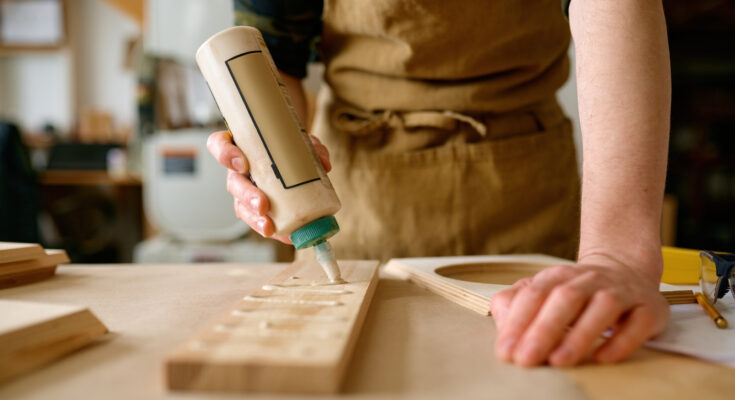The Strongest Wood Glue That’ll Make Your Next DIY Project Last Longer
We may receive a commission on purchases made from links.
All sorts of crafts, carpentry projects, and DIYs require the use of wood glue. But which version of this adhesive is the strongest and most reliable on the market? Unfortunately, the answer to this question varies somewhat depending on what you’re trying to do with the product. Heavy-duty outdoor building projects, for example, often require a completely different kind of glue than the type you’d use for assembling cabinets and drawers. However, if you’re just looking for a strong, reliable glue that’s suitable for most indoor woodworking applications, then wood glue made from polyvinyl acetate, or PVA, is usually a solid choice.
PVA wood glue often has a distinctive light-yellow color that differentiates it from other PVA products, such as white craft glue. It’s relatively inexpensive considering the strength of the bond it can create, and you can find it for sale at pretty much any hardware store or home goods retailer. Unlike some other types of adhesives that you can use on wood, such as epoxy, it doesn’t require mixing prior to application. It’s also non-toxic and doesn’t emit any fumes. If you’re looking to pick up a bottle of PVA wood glue for your workbench, Titebond III Ultimate Wood Glue is a reliable, top-rated pick. Once you’re familiar with how to use this product, you’ll find it easier than ever to do things like use leftover wood scraps in your garage for creative DIY projects. It’s also handy for things like furniture repairs and model making.
Tips for using PVA wood glue effectively
The strength of PVA wood glue depends, in part, on how well you’re applying it. To start with, you should always clean and dry the wood surfaces that you’re going to glue. Additionally, you should check to make sure that the joints or blocks that you’re working with fit together as tightly as possible. Even a small gap between your pieces can affect your project’s durability. Make sure to apply your glue to all of the surfaces that you’re planning to bond together. Don’t be afraid to use a generous amount; you can always clean away the excess with a damp cloth before it dries. If the excess glue dries before you can clean it up, try diluting some vinegar with water and then applying the mixture with a rag to the hardened residue so that it dissolves.
You should always use clamps in conjunction with PVA wood glue to prevent your projects from shifting or sliding while they’re drying. Spring clamps are great for small glue-ups, while F-clamps and bar clamps are usually more effective choices for larger builds. Make sure that your clamps are distributing pressure as evenly as possible. Also, always check the drying time listed on your glue’s packaging before removing your clamps. Most PVA wood glue will dry within an hour, so you’ll need to clamp your project for at least that long. However, the adhesive typically won’t be fully cured until twenty-four hours have passed.
When you should reconsider using PVA wood glue
PVA wood glue is a great option for all sorts of projects, but there are certain situations in which you might want to find a different adhesive product. If you need to create a waterproof bond, and not just a water-resistant one, you might want to reconsider your use of PVA glue. Additionally, you should never use PVA wood glue in the cold, since low temperatures can prevent the substance from curing properly. As a result of its limited water and temperature resistance, PVA glue ultimately isn’t the best choice for outdoor projects. If you’re doing something like building patio furniture or assembling an outdoor wood accent wall, you’re probably better off using a polyurethane-based glue instead.
PVA wood glue also typically isn’t the best choice if you’re trying to bond wood to another kind of material, such as metal or plastic. In these situations, you may want to try using epoxy glue. The two-part mixture has a bit more universal strength and can better handle surfaces that aren’t as porous as wood. It’s also worth noting that PVA glue typically doesn’t handle wood stain very well; if there’s a little bit of the adhesive visible in a joint, it will stand out. You can, however, often paint and sand down PVA wood glue without issue. Finally, for small repairs and craft projects, you can sometimes skip PVA products in favor of cyanoacrylate super glue, since the latter will dry faster.



